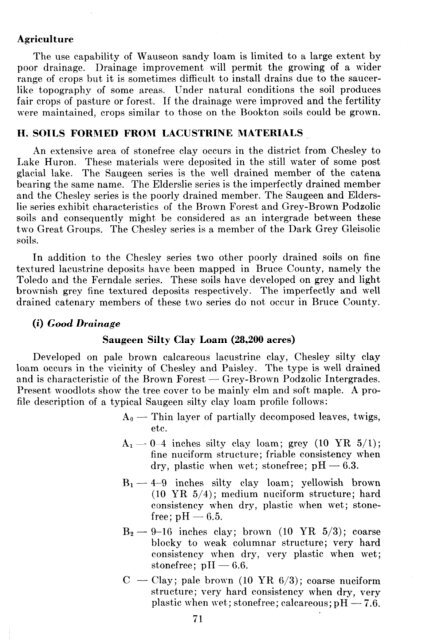GUELPH, ONTARIO - Agriculture and Agri-Food Canada
GUELPH, ONTARIO - Agriculture and Agri-Food Canada
GUELPH, ONTARIO - Agriculture and Agri-Food Canada
Create successful ePaper yourself
Turn your PDF publications into a flip-book with our unique Google optimized e-Paper software.
<strong><strong>Agri</strong>culture</strong><br />
The use capability of Wauseon s<strong>and</strong>y loam is limited to a large extent by<br />
poor drainage. Drainage improvement will permit the growing of a wider<br />
range of crops but it is sometimes difficult to install drains due to the saucerlike<br />
topography of some areas. IJnder natural conditions the soil produces<br />
fair crops of pasture or forest. If the drainage were improved <strong>and</strong> the fertility<br />
were maintained, crops similar to those on the Bookton soils could be grown.<br />
H. SOILS FORRIED FROM LACUSTRINE MATERIALS<br />
An extensive area of stonefree clay occurs in the district from Chesley to<br />
Lake Huron. These materials were deposited in the still water of some post<br />
glacial lake. The Saugeen series is the well drained member of the catena<br />
bearing the same name. The Elderslie series is the imperfectly drained member<br />
<strong>and</strong> the Chesley series is the poorly drained member. The Saugeen <strong>and</strong> Elderslie<br />
series exhibit characteristics of the Brown Forest <strong>and</strong> Grey-Brown Podzolic<br />
soils <strong>and</strong> consequently might’ be considered as an intergrade between these<br />
two Great Groups. The Chesley series is a member of the Dark Grey Gleisolic<br />
soils.<br />
In addition to the Chesley series two other poorly drained soils on fine<br />
textured lacustrine deposits have been mapped in Bruce County, namely the<br />
Toledo <strong>and</strong> the Ferndale series. These soils have developed on grey <strong>and</strong> light<br />
brownish grey fine textured deposits respectively. The imperfectly <strong>and</strong> well<br />
drained catenary members of these two series do not occur in Bruce County.<br />
(i) Good<br />
Drainage<br />
Saugeen Silty Clay Loam (28,200 acres)<br />
Developed on pale brown calcareous lacustrine clay, Chesley silty clay<br />
loam occurs in t,he vicinity of Chesley <strong>and</strong> Paisley. The type is well drained<br />
<strong>and</strong> is characteristic of the Brown Forest - Grey-Brown Podzolic Intergrades.<br />
Present woodlots show the tree cover to be mainly elm <strong>and</strong> soft maple. A profile<br />
description of a typical Saugeen silty clay loam profile follows:<br />
A0 - Thin layer of partially decomposed leaves, twigs,<br />
etc.<br />
A1 - O-4 inches silty clay loam; grey (10 YR 5/ 1) ;<br />
fine nuciform structure; friable consistency when<br />
dry, plastic when wet; stonefree; pH - 6.3.<br />
& - 4-9 inches silty clay loam; yellowish brown<br />
(10 YR 5,‘4); medium nuciform structure; hard<br />
consistency when dry, plastic when wet; stonefree;<br />
pH - 6.5.<br />
9-16 inches clay; brown (10 YR 5/3); coarse<br />
blocky to weak columnar structure; very hard<br />
consistency when dry, very plastic when wet;<br />
stonefree; pH - 6.6.<br />
Clay; pale brown (10 YR 6/3) ; coarse nuciform<br />
structure; very hard consistency when dry, very<br />
plast!ic when wet’; stonefree; calcareous; pH - 7.6.<br />
71

















